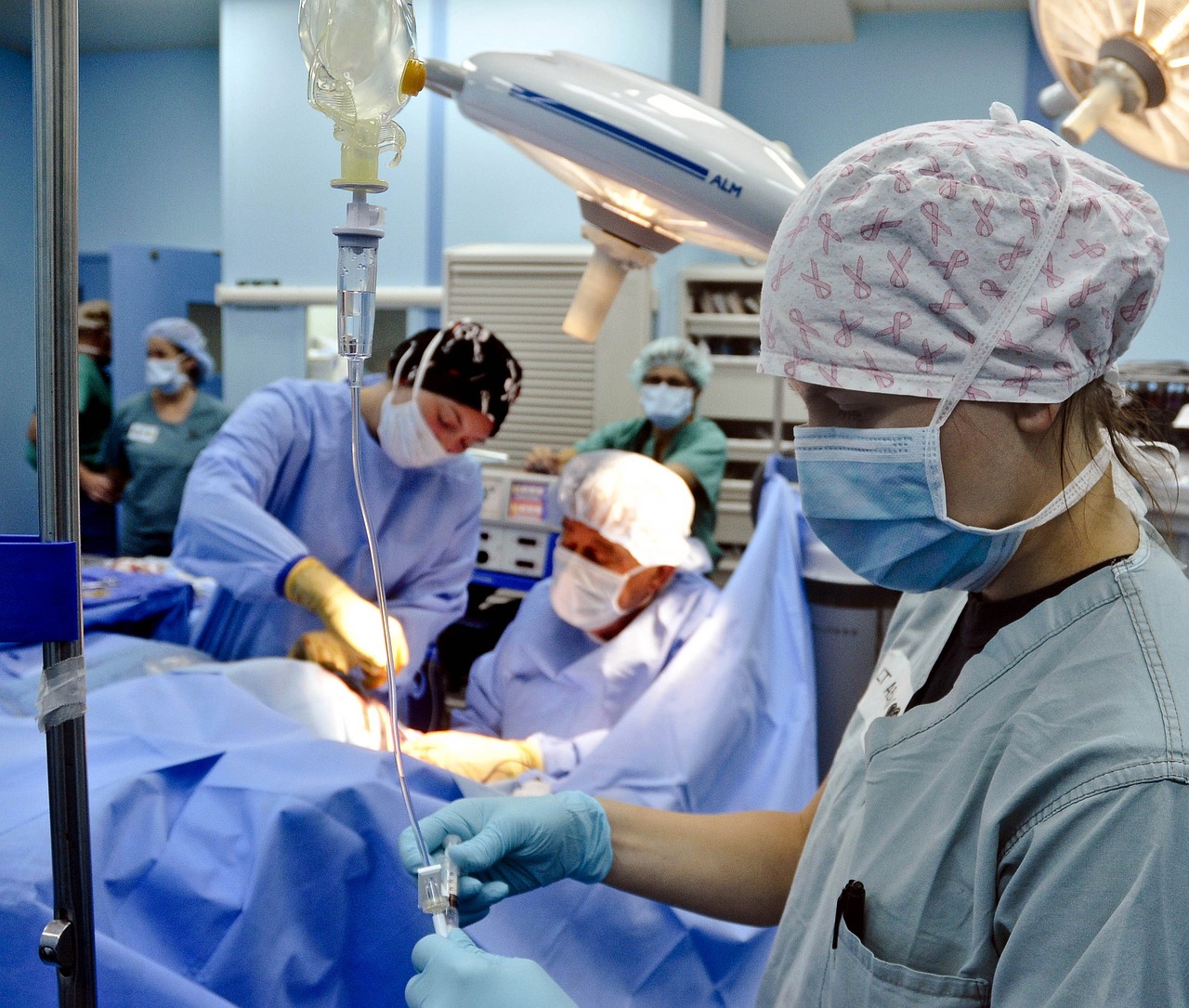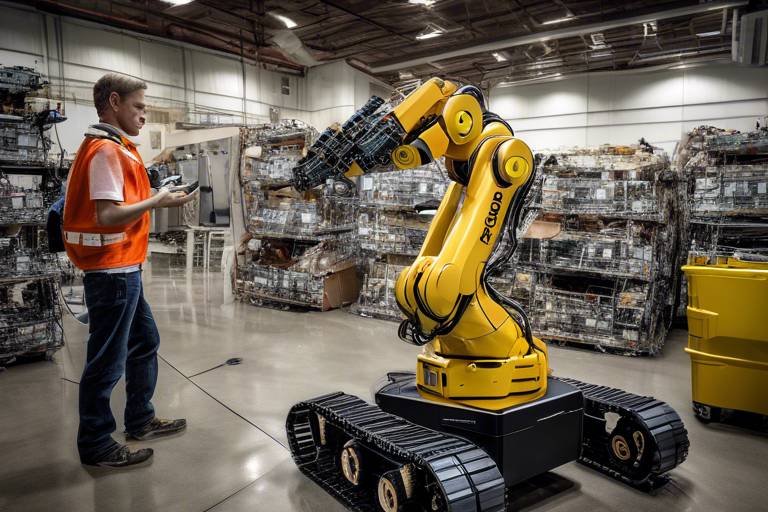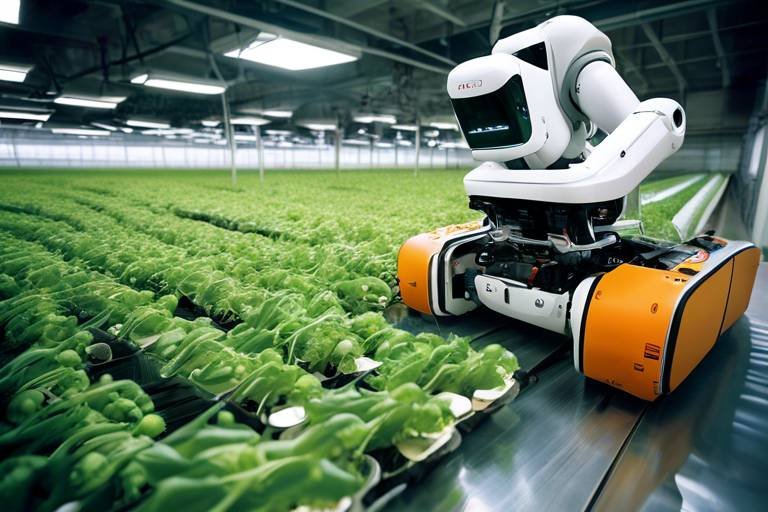Exploring the Science of Robotics in Surgery
The world of medicine has been radically transformed by the advent of technology, and one of the most groundbreaking innovations is the integration of robotics in surgery. Imagine a scenario where a surgeon, equipped with advanced robotic systems, can perform intricate procedures with unparalleled precision. This isn't just a dream; it's the reality of modern medicine. As we delve into the transformative role of robotics in surgical procedures, we will explore how these sophisticated systems enhance patient outcomes, improve surgical precision, and address the challenges that come with such advancements.
Robotic surgery has become a game-changer in the operating room, allowing for minimally invasive techniques that were once thought impossible. With robots taking the lead in certain procedures, surgeons can now operate with a level of control and accuracy that significantly reduces the risk of complications. But what does this mean for patients? It translates to smaller incisions, quicker recovery times, and ultimately, a better overall experience. The evolution of surgical robotics is not just about machines; it's about enhancing the human touch in medicine.
As we explore the historical development of surgical robotics, we can trace its roots back to early innovations that laid the groundwork for today's sophisticated systems. From the first robotic-assisted surgeries in the late 20th century to the advanced robotic platforms we see now, each milestone has brought us closer to redefining surgical practices. It's fascinating to think about how far we've come and the potential that lies ahead.
In the following sections, we will take a closer look at the various types of robotic surgical systems currently in use, such as the da Vinci Surgical System and ROSA. Each system boasts unique features and applications, catering to specific surgeries ranging from urology to orthopedics. As we dive deeper, we will uncover the advantages of minimally invasive techniques made possible by these robotic systems, and how they enhance precision and control during surgical procedures.
However, it's essential to recognize that while robotic surgery offers numerous benefits, it also comes with its share of challenges. The high costs associated with robotic systems, the technical complexities involved, and the necessity for specialized training can pose significant barriers to widespread adoption. As we navigate through these challenges, we will also look ahead to future trends in robotic surgery, including the integration of artificial intelligence and tele-surgery, which promise to further revolutionize the field.
Ultimately, our journey into the science of robotics in surgery will not only highlight the technological advancements but also address critical ethical considerations regarding patient safety and informed consent. As we embrace this new era of surgical innovation, it is crucial to ensure that technology complements the human element in healthcare, maintaining a focus on patient outcomes and satisfaction.
- What is robotic surgery? Robotic surgery involves the use of robotic systems to assist surgeons in performing surgical procedures with enhanced precision and control.
- What are the benefits of robotic surgery? Benefits include minimally invasive techniques, reduced recovery times, less pain, and a lower risk of complications.
- Are there risks associated with robotic surgery? Yes, potential risks include technical malfunctions and the need for specialized training for surgeons.
- How does robotic surgery compare to traditional surgery? Robotic surgery typically results in smaller incisions, shorter hospital stays, and quicker recovery compared to traditional open surgery.
- What types of surgeries can be performed robotically? Robotic systems can assist in various surgeries, including urological, gynecological, and orthopedic procedures.

The Evolution of Surgical Robotics
The journey of surgical robotics is nothing short of fascinating, reflecting the relentless pursuit of innovation in the medical field. It all began in the late 20th century, when pioneers in technology and medicine sought to merge the two disciplines, leading to the birth of robotic-assisted surgery. One of the first milestones was the introduction of the PUMA 560 in 1985, a robotic arm that assisted neurosurgeons in performing precise biopsies. This marked a significant leap forward, demonstrating that machines could enhance human capabilities in the operating room.
As we moved into the 1990s, the development of robotic systems gained momentum. In 1999, the da Vinci Surgical System was unveiled, revolutionizing the landscape of minimally invasive surgery. This system provided surgeons with enhanced visualization and dexterity, allowing them to perform complex procedures with greater precision. The da Vinci system utilized advanced 3D imaging and articulated instruments, mimicking the natural movements of a surgeon's hands while reducing the size of incisions needed for operations.
Fast forward to the 21st century, and surgical robotics has evolved significantly, with numerous advancements paving the way for more sophisticated systems. Today, we see a variety of robotic surgical platforms, each designed for specific applications, such as the ROSA robot for neurosurgery and the MAKO system for orthopedic procedures. These innovations are not just about improving outcomes; they are about transforming the entire surgical experience for both patients and surgeons.
The integration of robotics in surgery is supported by continuous research and development, with numerous clinical trials demonstrating the efficacy and safety of these technologies. For instance, studies have shown that robotic-assisted surgeries often result in shorter hospital stays, reduced pain, and faster recovery times compared to traditional surgical methods. This evolution is not merely a trend; it's a paradigm shift in how we approach surgical procedures.
In the coming years, we can expect even more groundbreaking advancements in surgical robotics. With the integration of artificial intelligence and machine learning, the potential for robotic systems to assist in diagnostics and pre-operative planning is immense. Imagine a future where robots can analyze vast amounts of data to create personalized surgical plans, optimizing outcomes for every patient.
Overall, the evolution of surgical robotics has been a remarkable journey, characterized by innovation, collaboration, and a commitment to improving patient care. As we look to the future, it’s clear that the integration of robotics in surgery will continue to enhance precision, safety, and efficiency, ultimately leading to better health outcomes for patients around the world.

Types of Robotic Surgical Systems
The landscape of robotic surgery is as diverse as it is innovative, featuring a variety of systems that cater to different surgical needs. At the forefront of this technological revolution is the da Vinci Surgical System, which has become synonymous with robotic-assisted surgery. This platform allows surgeons to perform complex procedures with unparalleled precision. Using a console, surgeons control robotic arms that hold surgical instruments and a camera, providing a 3D view of the surgical site. The da Vinci system is particularly popular for procedures in urology, gynecology, and thoracic surgery.
Another notable system is the ROSA Surgical Robot, designed primarily for neurosurgery and orthopedic procedures. The ROSA robot enhances the surgeon's capabilities by providing real-time imaging and navigation, allowing for less invasive approaches to complex surgeries. Its ability to assist in spinal surgeries and brain interventions has made it a game-changer in those fields.
In addition to these, there are several other robotic systems that are making waves in the surgical arena. For instance, the Versius Surgical Robot is gaining traction in the UK and beyond. This modular robot allows for flexibility in the operating room, adapting to various surgical specialties and enabling minimally invasive techniques. Its design is reminiscent of a human arm, allowing for a natural range of motion that can enhance surgical precision.
We also have the Senhance Surgical System, which incorporates haptic feedback, giving surgeons a tactile sensation during procedures. This system is particularly useful in laparoscopic surgeries, where the ability to feel the tissue can significantly improve outcomes. Each of these systems showcases unique features and capabilities, emphasizing the versatility of robotic surgery in addressing different medical challenges.
To better understand the various robotic surgical systems, let’s take a look at the following table that summarizes some key features:
| Robotic System | Primary Use | Key Features |
|---|---|---|
| da Vinci Surgical System | Urology, Gynecology, Thoracic | 3D visualization, precise instrument control |
| ROSA Surgical Robot | Neurosurgery, Orthopedics | Real-time imaging, navigation assistance |
| Versius Surgical Robot | General Surgery | Modular design, adaptable for various procedures |
| Senhance Surgical System | Laparoscopic Surgery | Haptic feedback, enhanced tactile sensation |
As we can see, the advancements in robotic surgical systems are not just about improving surgical outcomes; they also focus on enhancing the surgeon's experience and the patient's recovery journey. The integration of these sophisticated systems into operating rooms is revolutionizing the way surgeries are performed, making them safer and more efficient. It's fascinating to think about how far we've come in surgical technology and where we might be headed next. With each new development, we inch closer to a future where robotic systems could potentially handle a wider array of procedures, making healthcare more accessible and effective.

Minimally Invasive Techniques
In the realm of modern medicine, have revolutionized the way surgeries are performed. These techniques, which utilize advanced robotic systems, allow surgeons to conduct operations with smaller incisions compared to traditional methods. Imagine a world where the days of lengthy recovery periods and extensive scarring are becoming a thing of the past. Well, that world is here! The introduction of robotics into surgical procedures has not only enhanced precision but has also significantly improved patient outcomes.
One of the key advantages of these minimally invasive techniques is the reduction in trauma to the body. Smaller incisions mean less tissue damage, which translates to reduced pain and faster recovery times. Patients often find themselves back on their feet much sooner than they would with conventional surgery. For instance, while traditional open surgery might require a week or more for recovery, robotic-assisted procedures can often allow patients to return to their normal activities within just a few days. This is a game changer in the field of surgery!
Furthermore, the precision offered by robotic systems enables surgeons to operate in tight spaces with greater control. The dexterity of robotic instruments mimics the natural movements of the human hand but with enhanced stability and accuracy. This capability is particularly beneficial in complex procedures, such as those performed on delicate organs like the heart or in the pelvic region. Surgeons can navigate intricate anatomical structures with confidence, minimizing the risk of complications.
| Benefit | Description |
|---|---|
| Reduced Recovery Time | Patients experience quicker healing and can return to daily activities sooner. |
| Less Pain | Smaller incisions lead to less trauma, resulting in lower pain levels post-surgery. |
| Lower Risk of Infection | Minimized exposure of internal organs decreases the likelihood of infections. |
| Improved Cosmetic Outcomes | Smaller scars lead to better aesthetic results, enhancing patient satisfaction. |
However, while the benefits are substantial, it's essential to acknowledge that the transition to minimally invasive techniques does come with its own set of challenges. Surgeons must undergo specialized training to master the nuances of robotic systems. The learning curve can be steep, but the rewards—both for the surgeon and the patient—are well worth the effort. As technology continues to evolve, ongoing education and training will be crucial to ensure that medical professionals are equipped to utilize these advanced tools safely and effectively.
In conclusion, the rise of minimally invasive techniques in robotic surgery is not merely a trend; it's a transformative movement that promises to enhance the surgical experience for both patients and healthcare providers. As we look to the future, we can only imagine how these advancements will continue to shape the landscape of medicine, making procedures safer, less invasive, and more efficient than ever before.
- What are the advantages of minimally invasive surgery? Minimally invasive surgery offers benefits such as reduced recovery time, less pain, lower risk of infection, and improved cosmetic outcomes.
- How does robotic surgery enhance precision? Robotic systems provide surgeons with advanced instrumentation that allows for greater control and accuracy during procedures.
- What training is required for surgeons to perform robotic surgery? Surgeons must undergo specialized training programs that include hands-on experience with robotic simulators to develop the necessary skills.
- Are there any risks associated with robotic surgery? While robotic surgery is generally safe, it can present challenges such as technical complexities and the need for specialized training.

Enhanced Precision and Control
When it comes to surgery, precision is not just a luxury; it's a necessity. Robotic systems have revolutionized the way surgeons approach complex procedures, allowing for an unprecedented level of accuracy and control. Imagine trying to thread a needle with your eyes closed; that’s what traditional surgery can feel like sometimes. With robotic systems, surgeons gain enhanced visualization and dexterity, making intricate maneuvers much easier and safer.
One of the standout features of robotic surgical systems, like the da Vinci Surgical System, is their ability to translate a surgeon's hand movements into smaller, more precise actions within the patient's body. This is akin to using a remote control to operate a miniature robot that can navigate through tight spaces. The robotic arms can rotate and bend in ways that human hands simply can’t, allowing for greater flexibility and minimized trauma to surrounding tissues.
Furthermore, these systems come equipped with advanced imaging technology, providing surgeons with a 3D view of the surgical site. This enhanced visualization is critical for identifying structures and making informed decisions during the procedure. The combination of high-definition cameras and robotic instrumentation results in a level of detail that traditional methods often lack.
For instance, consider a scenario in which a surgeon is performing a prostatectomy. The ability to maneuver the robotic instruments with precision allows for the sparing of nerves and blood vessels, which can lead to better functional outcomes post-surgery. This is not just about cutting; it’s about cutting with intention and care.
However, it’s important to note that this enhanced precision does not come without its challenges. Surgeons must undergo extensive training to master these systems. The learning curve can be steep, but the investment in training pays off as it significantly reduces the risk of complications. According to studies, hospitals that implement rigorous training programs for their surgical teams often see improved patient outcomes.
To summarize, the enhanced precision and control offered by robotic surgical systems are transforming the landscape of modern medicine. With their ability to minimize invasiveness and maximize accuracy, they are not just tools; they are partners in the surgical process. As technology continues to evolve, we can only expect these systems to become even more sophisticated, paving the way for a future where surgery is safer, more effective, and less daunting for patients.
- What are the main advantages of robotic surgery? Robotic surgery offers enhanced precision, reduced recovery times, and minimal scarring compared to traditional surgical methods.
- Are there risks associated with robotic surgery? Like any surgical procedure, there are risks, including potential complications and the need for specialized training for surgeons.
- How does robotic surgery improve patient outcomes? By allowing for minimally invasive techniques, robotic surgery can lead to quicker recovery times, less pain, and lower rates of complications.
- What types of surgeries can be performed robotically? Robotic systems are used in various procedures, including prostatectomies, hysterectomies, and cardiac surgeries.

Training and Simulation for Surgeons
In the world of modern medicine, where precision is paramount, the role of training and simulation for surgeons cannot be overstated. As robotic surgical systems become increasingly sophisticated, the need for surgeons to master these technologies has never been greater. Just like a pilot who spends countless hours in a flight simulator before taking to the skies, surgeons must undergo rigorous training to ensure they can operate robotic systems with the utmost skill and confidence. This training not only involves understanding the mechanics of the robotic systems but also mastering the unique techniques that robotic surgery demands.
Robotic surgical simulators provide a safe and controlled environment for surgeons to practice their skills without putting patients at risk. These simulators use advanced technology to replicate the feel and response of actual robotic systems, allowing surgeons to hone their dexterity and decision-making skills. Imagine trying to learn how to play a musical instrument without a practice session; it’s a similar concept in surgery. The more familiar a surgeon becomes with the robotic system through simulation, the better prepared they are to handle real-life scenarios.
Moreover, training programs often incorporate a variety of learning methods to cater to different learning styles. For instance, some surgeons may benefit from hands-on practice, while others might prefer virtual simulations or even augmented reality experiences. This multifaceted approach helps to ensure that all surgeons, regardless of their initial skill level, can become proficient in robotic surgery. The ultimate goal is to create a team of surgeons who are not only technically skilled but also capable of making quick, informed decisions during surgery, which is crucial in high-stakes situations.
To illustrate the importance of training and simulation, consider the following table that outlines common training methods used in robotic surgery:
| Training Method | Description | Benefits |
|---|---|---|
| Virtual Reality Simulators | Simulates real-life surgical scenarios in a virtual environment. | Enhances spatial awareness and hand-eye coordination. |
| Hands-On Workshops | In-person training sessions with robotic systems. | Provides direct experience and immediate feedback. |
| Online Courses | Web-based training modules covering robotic surgery fundamentals. | Flexible learning pace and accessibility. |
| Peer-to-Peer Training | Experienced surgeons mentor less experienced colleagues. | Fosters collaboration and knowledge sharing. |
While the advantages of training and simulation are clear, it’s also essential to recognize the ongoing nature of this education. As technology continues to evolve, so too must the training programs. Continuous education ensures that surgeons remain up-to-date with the latest advancements in robotic surgery, which ultimately translates to better patient outcomes. So, the next time you hear about a groundbreaking robotic surgery, remember that behind that success is a well-trained surgeon who has dedicated countless hours to mastering their craft through simulation and practice.
- What is the importance of simulation in surgical training? Simulation allows surgeons to practice and refine their skills in a risk-free environment, enhancing their proficiency with robotic systems.
- How long does it take to become proficient in robotic surgery? The time varies by individual, but extensive training and practice are essential, often taking several months to years.
- Are there specific certifications for robotic surgeons? Yes, many institutions offer specialized certifications in robotic surgery that validate a surgeon's expertise.
- Can simulation replace traditional surgical training? While simulation is a valuable tool, it complements rather than replaces traditional training methods.

Challenges and Limitations of Robotic Surgery
While robotic surgery has revolutionized the field of medicine, making procedures more precise and less invasive, it is not without its challenges and limitations. One of the primary hurdles is the cost associated with acquiring and maintaining robotic surgical systems. These systems can cost upwards of several million dollars, which can be a significant barrier for many hospitals, especially smaller facilities. Additionally, the high cost often translates into increased expenses for patients, leading to questions about accessibility and equity in healthcare.
Another challenge is the technical complexity of robotic systems. Surgeons must undergo extensive training to operate these advanced machines effectively. This training can take months, and not all surgical teams may have the resources or time to become proficient. Furthermore, the reliance on technology can lead to a potential skills gap. In the event of a system malfunction or failure, surgeons must be prepared to switch back to traditional methods quickly, which can be daunting if they haven't practiced those skills recently.
Moreover, there are concerns about the learning curve associated with robotic surgery. Newer surgeons may find themselves facing a steep learning curve, which could impact patient safety during their initial procedures. It's crucial for hospitals to implement robust training programs and mentorship opportunities to ensure that all surgical teams are adequately prepared.
Another aspect worth considering is the patient's perspective. While many patients are enthusiastic about robotic surgery due to its minimally invasive nature, there can be a lack of understanding regarding the potential risks involved. Patients may be unaware that robotic surgery is still performed by human surgeons, and the technology is merely a tool to assist in the procedure. This can lead to unrealistic expectations about outcomes and recovery times.
Furthermore, the ethical implications surrounding robotic surgery cannot be ignored. Issues related to informed consent arise when patients are not fully educated about the risks and benefits of robotic procedures compared to traditional methods. Ensuring that patients have a comprehensive understanding of their options is essential for ethical practice in medicine.
Lastly, there is the challenge of integration. As robotic surgery continues to evolve, integrating new technologies and systems into existing surgical practices can be complex. Hospitals must navigate the logistics of training staff, updating protocols, and ensuring that all team members are on the same page regarding the use of robotic systems.
In summary, while robotic surgery offers numerous advantages that can enhance patient outcomes, it also presents significant challenges that must be addressed. From cost and technical complexities to ethical considerations and integration issues, the medical community must work collaboratively to overcome these hurdles and ensure that robotic surgery is a safe and effective option for all patients.
- What are the main advantages of robotic surgery?
Robotic surgery offers enhanced precision, reduced recovery times, and smaller incisions compared to traditional surgery. - Are there risks associated with robotic surgery?
Yes, while robotic surgery is generally safe, there are risks such as potential system malfunctions and the learning curve for surgeons. - How much does robotic surgery typically cost?
The costs can vary significantly but often range from several thousand to tens of thousands of dollars, depending on the procedure and facility. - Is robotic surgery suitable for all patients?
Not all patients are candidates for robotic surgery; it depends on individual health conditions and the type of procedure required.

Future Trends in Robotic Surgery
The landscape of robotic surgery is evolving at a breathtaking pace, and the future is brimming with possibilities that could redefine how we approach surgical procedures. Imagine a world where surgeries are not only more precise but also more accessible, thanks to advancements in technology. One of the most exciting trends is the integration of artificial intelligence (AI) into robotic systems. AI has the potential to analyze vast amounts of data in real-time, assisting surgeons by providing insights and recommendations tailored to individual patients. This could lead to even greater precision and improved outcomes, as the system learns from each surgery and continually refines its algorithms.
Another significant trend is the rise of tele-surgery, which allows surgeons to operate on patients from remote locations using robotic systems. This could be a game-changer, especially in underserved areas where access to specialized surgical care is limited. Imagine a skilled surgeon in a metropolitan hospital performing a complex procedure on a patient hundreds of miles away, all facilitated by cutting-edge technology. The ability to bridge geographical barriers not only enhances patient access but also optimizes the use of surgical expertise across different regions.
Moreover, we are witnessing an expansion in the applications of robotic surgery across various medical fields. While urology and gynecology have been the frontrunners, new robotic systems are being developed for orthopedic, cardiac, and even neurosurgical procedures. As these technologies continue to advance, we can expect to see more minimally invasive techniques being utilized, which are associated with shorter recovery times and less postoperative pain. The future of robotic surgery is not just about enhancing existing procedures; it's about transforming the entire surgical experience for patients and healthcare providers alike.
In addition to these advancements, there is a growing emphasis on collaborative robotics in the operating room. This concept involves the use of multiple robotic systems working in tandem, allowing for enhanced efficiency and coordination during surgeries. Picture a scenario where one robot assists with suturing while another manages camera control, all under the watchful eye of a skilled surgeon. This level of collaboration could significantly reduce surgery times and improve patient outcomes.
As we look ahead, it's essential to address the ethical considerations that accompany these advancements. With the integration of AI and tele-surgery, questions about patient safety, informed consent, and the role of human oversight become increasingly critical. The medical community must navigate these challenges carefully to ensure that technological progress does not compromise the fundamental principles of patient care.
In conclusion, the future of robotic surgery is bright, filled with innovations that promise to enhance precision, accessibility, and overall patient outcomes. As these technologies continue to develop, we can only imagine the possibilities that lie ahead. Will we see robotic systems that can perform surgeries autonomously? Only time will tell, but one thing is certain: the journey of robotic surgery is just beginning, and the potential is limitless.
- What is robotic surgery? Robotic surgery involves the use of robotic systems to assist surgeons in performing minimally invasive procedures with greater precision and control.
- How does AI enhance robotic surgery? AI can analyze data in real-time, providing surgeons with insights that improve decision-making and surgical outcomes.
- What is tele-surgery? Tele-surgery allows surgeons to perform operations on patients remotely using robotic systems, expanding access to specialized care.
- What are the benefits of minimally invasive techniques? These techniques typically result in smaller incisions, reduced recovery times, and less postoperative pain for patients.

Patient Safety and Ethical Considerations
When it comes to robotic surgery, the conversation around patient safety and ethical considerations is more crucial than ever. As these advanced technologies become commonplace in operating rooms, it’s essential to examine their implications on patient care. One of the primary concerns is ensuring that patients are fully informed about the risks and benefits associated with robotic procedures. Informed consent is not just a formality; it’s a fundamental ethical requirement that empowers patients to make educated decisions regarding their health.
Moreover, the complexity of robotic systems raises questions about the role of human oversight. While robots can enhance precision and minimize invasiveness, they are still operated by humans who must be adequately trained. This leads us to consider the potential for errors. Although robotic systems are designed to reduce the risk of complications, the possibility of technical malfunctions or misjudgments by the surgeon cannot be ignored. Therefore, a robust training program is essential for surgeons to navigate these sophisticated machines effectively.
Another layer of ethical consideration involves the equity of access to robotic surgery. These advanced systems often come with a hefty price tag, which can limit their availability to certain hospitals or regions. This disparity raises concerns about whether all patients, regardless of their socioeconomic status, can benefit from the latest advancements in medical technology. As we embrace the future of robotic surgery, it is vital to ensure that these innovations are accessible to all, not just the privileged few.
In addition to these concerns, we must also consider the psychological impact on patients. The idea of having surgery performed by a robot can be intimidating for some. Ensuring that patients feel comfortable and confident in the technology being used is essential for their overall satisfaction and peace of mind. Healthcare providers must take the time to address any fears or misconceptions about robotic surgery, providing reassurance and clarity.
As we move forward, it’s crucial to establish ethical guidelines that govern the use of robotic surgery. These guidelines should focus on ensuring patient safety, promoting equitable access, and maintaining a strong emphasis on informed consent. By doing so, we can harness the incredible potential of robotic surgery while safeguarding the interests and well-being of patients.
- What are the main benefits of robotic surgery?
Robotic surgery offers numerous benefits, including enhanced precision, reduced recovery times, and minimally invasive techniques that can lead to less pain and scarring. - Is robotic surgery safe?
While robotic surgery is generally considered safe, it does come with risks, and it’s essential for patients to discuss these with their healthcare providers. - How do surgeons get trained to use robotic systems?
Surgeons undergo extensive training, often utilizing simulators and hands-on practice to develop the skills necessary to operate robotic surgical systems effectively. - Are there ethical concerns regarding robotic surgery?
Yes, ethical concerns include informed consent, the need for human oversight, and equitable access to advanced surgical technologies.

Patient Outcomes and Satisfaction
When it comes to robotic surgery, one of the most compelling aspects is its impact on patient outcomes and overall satisfaction. Studies have shown that patients who undergo robotic-assisted procedures often report a higher level of satisfaction compared to traditional surgical methods. This can be attributed to several factors, including reduced recovery times, less postoperative pain, and lower rates of complications. Imagine having a surgery that allows you to return to your daily activities faster and with less discomfort—it's no wonder patients are excited about this technology!
Research indicates that patients experience significant benefits from robotic surgery. For instance, a recent study revealed that patients who underwent robotic-assisted prostatectomies had:
| Outcome | Robotic Surgery | Traditional Surgery |
|---|---|---|
| Average Hospital Stay | 1.5 days | 3.5 days |
| Postoperative Pain Level (1-10) | 3 | 6 |
| Complication Rate | 2% | 5% |
This table highlights the stark differences in recovery experiences, showcasing how robotic surgery can lead to a smoother and quicker recovery. Patients often express their relief at experiencing minimal scarring and faster healing, which adds to their overall satisfaction. Furthermore, the minimally invasive nature of robotic procedures means that patients can often return to their normal routines much sooner than they would after traditional surgeries.
Moreover, the psychological aspect of surgery shouldn't be overlooked. Knowing that a highly advanced robotic system is assisting in their procedure can provide patients with a sense of confidence and reassurance. Many patients feel that they are receiving cutting-edge care, which can significantly enhance their overall experience. In fact, a survey conducted among patients who had undergone robotic surgery showed that:
- 85% felt well-informed about their procedure.
- 90% reported satisfaction with their surgical team’s communication.
- 80% would recommend robotic surgery to others.
These statistics are not just numbers; they reflect the profound impact that robotic surgery has on patient perceptions and experiences. Additionally, follow-up care plays a crucial role in patient satisfaction. Surgeons who utilize robotic systems often have enhanced capabilities to monitor recovery, leading to better long-term outcomes.
In conclusion, the intersection of technology and surgery has ushered in a new era of patient care. Robotic surgery not only improves clinical outcomes but also enhances patient satisfaction. As this field continues to evolve, it is essential to maintain a focus on patient-centered care, ensuring that individuals feel supported and informed throughout their surgical journey. The future of robotic surgery looks promising, and patients can anticipate even more advancements that will further improve their experiences.
Frequently Asked Questions
- What is robotic surgery?
Robotic surgery refers to surgical procedures performed with the assistance of robotic systems. These systems enhance the surgeon's capabilities, allowing for more precise movements and better visualization during operations.
- How does robotic surgery differ from traditional surgery?
Unlike traditional surgery, which often involves larger incisions, robotic surgery utilizes minimally invasive techniques. This means smaller cuts, reduced pain, quicker recovery times, and less scarring for patients.
- What are the benefits of robotic-assisted surgery?
Robotic-assisted surgery offers several advantages, including enhanced precision, reduced risk of complications, shorter hospital stays, and faster recovery times. Patients often experience less pain and can return to their normal activities sooner.
- Are there any risks associated with robotic surgery?
As with any surgical procedure, there are risks involved. These may include potential complications from anesthesia, bleeding, infection, or issues related to the robotic system. However, when performed by trained professionals, these risks are generally low.
- What types of surgeries can be performed using robotic systems?
Robotic systems can assist in various types of surgeries, including urological, gynecological, and cardiac procedures. Each system has unique capabilities tailored to specific surgical needs.
- How are surgeons trained to use robotic systems?
Surgeons undergo extensive training to operate robotic systems, often starting with simulation programs that mimic the robotic environment. This training is crucial for developing the skills necessary for effective and safe robotic surgery.
- What is the future of robotic surgery?
The future of robotic surgery looks promising, with advancements in artificial intelligence, tele-surgery, and expanded applications across various medical fields. These innovations aim to improve patient outcomes and enhance the surgical experience.
- How do patients feel about robotic surgery?
Many patients report high satisfaction rates with robotic surgery due to the benefits of quicker recovery, less pain, and improved outcomes. Studies show that patients often appreciate the minimally invasive approach and the expertise of their surgical team.
- Is robotic surgery covered by insurance?
Coverage for robotic surgery varies by insurance provider and specific plans. It's essential for patients to check with their insurance company to understand what is covered and any potential out-of-pocket costs.


















